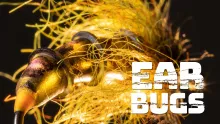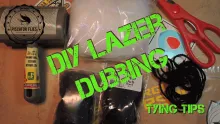This small section with advice on dyeing fly tying materials was made after a discussion took place on the European fly fishing mailing list. The text was put together from input from several people of this list: Graham Ward, John Davies, Pat Orpen and myself.
This small section with advice on dyeing fly tying materials was made after a discussion took place on the European fly fishing mailing lis. The text was put together from input from several people of this list: Graham Ward, John Davies, Pat Orpen and myself.
Short introduction to dyeing materials
by Graham Ward
I started dying my own materials about 7 or 8 years ago because I could not get the materials or colours I wanted from shops or suppliers.
I have given up trying to die anything black because of the amount of dye you have to use.
I have not had problems with any other colours, including fluorescent.
I have found by trial and error that Veniard powder dyes suit me best.
You will only get a true colour if the material you are dying is white to start with.
I have not tried bleaching any fur or feather. I have never found this necessary.
I have successfully dyed the following skins:
- Rabbit - Hare - Deer - Mole - Squirrel. Silver Fox tails.
- Capes - the most successful being cheap saddles from white.
- Canada Goose and Swan wing feathers to be used as herl for nymph and dry fly bodies.
- Marabou and Ostrich plumes.
- Mohair - for dubbing. I buy this from wool shops, when they have sales, as a large ball of white. I then cut in into hanks and dye it up the required colour. When dry the the hair can be plucked off.
Drying the material
First lay it out on newspaper. This absorbs water very quickly. Change the newspaper when it gets wet. It is best to allow all materials to dry out as naturally as possible. I then place them on the floor on some absorbent kitchen paper near a radiator to dry out at room temperature.
Don't be tempted to hurry the process by placing on radiator or in airing cupboard.
Equipment and Materials for Dyeing
by John Davies
Equipment and Materials suggested for Dyeing Fly Tying Materials:
- Apron - to protect clothes from dye splashes.
- Teaspoon or spatula - for measuring out dye powder.
- Malt vinegar or acetic acid - dye fixative.
- measure - for 10ml of vinegar i.e. a tablespoon.
- Measuring jug - for one litre or one pint of water.
- Stainless steel saucepan - with matching sieve. (Enamel or metal are OK)
- Tongs - or long tweezers.
- Small sieve - for small items.
- Slotted spoon - for bulk dying several items.
- Venpol - or Lux Flakes.
- Veniard de-greaser - for heavily soiled items.
- LARGE supply of newspapers.
- Thermometer - Suitable for purpose, reading up to 100 degrees Centigrade
Martin Joergensen adds:
Consider the risc that everything that comes in contact with the very strong dye can take the color permanently - wooden and plastic objects, saucepans and kettels covered with residues of calcium from the water, all kinds of fabrics - including clothes - and not least skin. Use plastic gloves if you want to be shure not to have your fingers dyed.
Graham Ward also adds:
A further item of equipment which I regard as essential is a pair of rubber gloves. In particular to protect the hands from accidental spills of dye powder. If it's on the gloves it can be washed off without any problem
under the tap. If it is on the skin perspiration/damp activates it immeadiately with colourful results and it is difficult to remove because it is concentrated.
I have never needed Venpol or Veniard de-greaser. I soak all materials to be dyed in a mixture of warm water and washing up liquid. The same amount as for normal washing of dishes. After soaking rinse in cold water. Be
very careful if you dye materials in the kitchen. You are using a permanent dye and if you are not careful parts of your kitchen can end up the same colour.
Step-by-step dyeing
by John Davies
Method for Dying:
- Boil one litre (two pints) of water in a saucepan.
- Add 1.25 ml or a quarter of a tea spoon of dye to the pan and stir until dissolved. (N.B. Black and other dark shades will require a stronger dyebath either twice or quadruple the normal strength)
- Bring the dyebath to a simmer, then add 10ml of vinegar, which will cause the bath to boil. It has been noted that 92 degrees Centigrade has been suggested as the optimum dye bath temperature.
- When the bath has stabilised, add the material to be dyed and keep it moving in the bath all of the time. Do not allow the bath to boil with materials in the bath, especially feathers.
- Take the material out of the bath at regular intervals to examine the amount of dye penetration. Some material will need to be washed and dried with a hair dryer to assess the correct shade.
- When correct shade has been reached, the material is then washed until no dye colour can be seen in the rinse water.
Use of a microwave for dyeing fly tying materials
by Pat Orpen
The use of the microwave for small quantities of fur or feather is quite simple,and easily controlled.
- Prepare the material in the normal way
- Use a 2 or 4 cup Pyrex measuring cup, filling it half
- Add the dye--just a VERY small amount does the job
- Bring to the boil in the micro and IMMEDIATELY remove it from the chamber
- Check colouring progress
- Add a tablespoon of white vinegar, return to micowave
- Cycle again until it reaches boiling, and remove.
- Rinse well in cold water
I have found this a lot simpler and quicker than the saucepan and stove deal. Of course, it's no good for a production tyer!
The use of fabric dye on fly tying materials
by Martin Joergensen
Treatment of hair materials before using or dyeing
Wash it with a mild hair shampoo and rinse it with hair conditioner. Dry it thoroughly with a blow dryer while combing it and hang to dry for days.
Check out Wayne Luallen's section for an expert's advice on any kind of cleaning.
Dyeing fox tail with fabric dye
I have washed and dyed a silver fox tail with great success. I cut the untreated (but already clean) tail in small pieces. Anybody who has tried will know that a 2 by 2 centimeters patch of skin will hold hair for a wealth of flies. Each piece was soaked in warm water and I tried dying them with fabric dyes of the brand Dylon.
I did gray, olive and purple. The colors were a bit light, but very nice. Using more color would probably have helped, but even
better would have been proper dyes, like the ones from Vienyard.
I dyed each patch in a small stainless steel container and just followed the instructions for fabric.
Easy and highly recommended.
Collecting and preserving materials
by Graham Ward
Hen and Cock Pheasant - Partridge - Mallard duck - Teal - Jay - Crow - Rabbit - Hare and Squirrel mainly come from friends who shoot game and vermin. The game shooting season is from October to February. Another source is game dealers from whom I occasionally buy Pheasants and Duck to eat.
Whatever the source I like the material to be fairly fresh ( no more than two days after it has been killed). As far as birds are concerned I do not skin them. Body feathers I pluck. Wings I normally cut off. I remove any meat and then dry them naturally in their pairs to ensure that I shall have matching feathers. Swan and Canada Goose feathers I normally collect in the Summer when the birds have moulted and the feathers can be found at the lake side. If feathers are dirty they can be washed and then dried
naturally.
Rabbit - Hare - Squirrel (and Moles) I skin. I then nail them out on a board so that the skin is stretched - fur side to the board raw skin uppermost. I then liberally sprinkle Borax on to the raw skin and rub it in. All I am trying to do is dry the skin off not tan it, that is an entirely different process. I check the skin at regular intervals and if there are still wet patches I rub in more Borax until it is dry.
Normally this only takes about 3 or 4 days and it is then ready for use. These skins have only been preserved to use the fur for body materials. Care must be taken when skinning to ensure that this is cleanly done and there aren't bits of meat and fat adhering to it because this will make the drying process longer. With Squirrel tails I remove any fat/meat from the base. Rub in borax and dry them. I have also done the same with bucktails.
When storing fur or feather it must be dry and free from any material that can go rotten and contaminate it. The place where you store it must also be dry. I normally place the fur or feather in large plastic bags into which I also place a moth ball which contains Naphthalene it says on the box " Insecticide for amateur use as a moth repellent to prevent insect damage for stored woollens,furs,linens,clothing and bedding in domestic situations".
I have used these methods of preservation and storage for about 15 years and have never had any problems.
To sum up I think the important points are as follows:
- Always ensure that you know the source of the raw material and that it is fresh.
- Ensure that it is dry and free from contamination when you store it.
- Always store it with some form of safe domestic insecticide.
- Log in to post comments








how do you dye polye
how do you dye polyester please
Can this method be a
Can this method be applied to swan feathers?